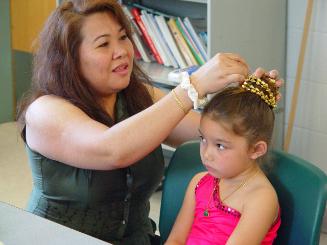Southern New England Traditional Arts Apprenticeship Program Year 6 - Interview with Khene Teacher and Apprentice
Date2003 July 16
Mediumreformatted digital file from audio cassette
DimensionsDuration (side 1): 46 Minutes, 54 Seconds
Duration (side 2): 16 Minutes, 36 Seconds
Duration (total runtime): 1 Hours, 3 Minutes, 37 Seconds
ClassificationsInformation Artifacts
Credit LineConnecticut Cultural Heritage Arts Program collections
CopyrightIn Copyright
Object number2015.196.671a-d
DescriptionAudio cassette tape of Lynne Williamson and Winifred Lambrecht interviewing khene player and teacher Bounleaune Ketnavong and apprentice Khamphone Phonekeo at Khamphone's home in Killingly, about their apprenticeship under the Southern New England Traditional Arts Apprenticeship Program in years 5 and 6 (2002-2004) on July 16, 2003.
NotesSubject Note/ The Lao national instrument, khene, is a tall mouth organ made from multiple reed pipes bound together and held upright when played. Khene playing features centrally in traditional festivities and ceremonies in Laos, and at Lao New Year celebrations and family gatherings in New England. Because it can be difficult to learn the breath control, fingerings, melodies, and drones important to khene playing, few students have taken this on in the U.S.Biographical Note: Based in Dudley MA after immigrating to the US, khene player Bounleuane Ketnavong learned to play from his father, and passed on his skills to members of the Lao community in northeastern Connecticut during Years 5 and 6 (2002-2004) of CCHAP’s Southern New England Traditional Arts Apprenticeship Program. Khamphone Phonekeo served as Community Outreach Coordinator in the successful Lao Cultural Program at Killingly Central Schools. Students there participated in activities such as a traditional dance group and New Year Festival. Two of the boys from the group - Sulisay Phonekeo, Khone Thoummany - as well as Khamphone learned khene playing under this apprenticeship. The group presented their learning in a concert at the 2003 Dayville CT Goodyear School multicultural event showcasing the apprenticeship between teaching artist Bounleaune Ketnavong and Khamphone Phonekeo in Lao khene playing, along with other Lao students at the school. A young dancer, Tamala Phongsavad, learned Laotian dance with Manola Sidara and she performed at this event. The apprentices also performed in the Lao New Year Celebration at Jefferson School in New Britain in 2004. Dayville and Killingly in eastern Connecticut had a sizeable Lao population in the 1990s and early 2000s, many were working at the Franklin mushroom farm. After the farm closed, many moved elsewhere in Connecticut and other states.
Subject Note: The Southern New England Traditional Arts Apprenticeship Program is a CCHAP initiative since 1997 that fosters the sharing of community-based traditional (folk) artistic skills through the apprenticeship learning model of regular, intensive, one-on-one teaching by a skilled mentor artist to a student/apprentice. The program pairs master artists from Rhode Island, Massachusetts, or Connecticut with apprentices from one of the other states, as a way to knit together members of the same community or group across state lines. Teaching and learning traditional arts help to sustain cultural expressions that are central to a community, while also strengthening festivals, arts activities and events when master/apprentice artists perform or demonstrate results of their cooperative learning to public audiences. The Connecticut Cultural Heritage Arts Program at the Connecticut Historical Society manages the program in collaboration with the Folk Arts Program at the Massachusetts Cultural Council and independent folklorist Winifred Lambrecht who has a deep knowledge of the folk arts landscape of Rhode Island. Primary funding for the program comes from the National Endowment for the Arts, with support also from the Connecticut Commission on the Arts, the Institute for Community Research, and the Connecticut Historical Society.
Subject Note: Connecticut was a major resettlement site for Southeast Asians in the 1980's. The Lao population numbers over 3000, living primarily in urban areas such as New Britain, Bridgeport, East Hartford, and Danbury and for a time in the 1990s-2007, in rural eastern Connecticut. While many Lao have found employment in factories, service industries, farming, and trades such as food, they continue to face barriers of language, lack of education, and lower income levels, all against a common backdrop of serious emotional wounds from the Viet Nam War era. Youth aged 10 - 19 years old have been by far the largest age group among Connecticut Southeast Asians. Maintaining young peoples’ awareness of heritage, culture, values, and language is a major goal of Lao leaders and parents. The Lao community sustains its traditional cultural practices in several ways. Several temples around the state provide gathering places where Buddhist monks and nuns offer spiritual services and cultural festivals. The largest temple is in Morris, where the resident monk Khoutavong has created exquisite Buddhist statues and traditional architecture with symbolic carvings, ornamentation, and shrines. Dancer and educator Manola Sidara developed and has directed Lao Narthasin, a traditional dance group now in its third generation of dancers. They perform classical, folk, and social dances that highlight cultural values such as respectful behavior and appreciation for elders. Manola also specializes in creating ceremonial decorations that express wellness, spirituality, and bonding during community celebrations, and she also promotes health and healing through her work as a master chef. The Lao Association of Connecticut formed in 1980 to unite the community and assist in economic development, cultural preservation, education, and health. For many years LAC offered classes in language, history, food and medicine, verbal arts, traditional music, and singing at Jefferson School in New Britain, and the group organizes several heritage festivals each year at the Morris temple that are attended by hundreds of Lao people. Other Lao community groups around the state also develop and present spiritual and cultural programs as well as health initiatives.
Additional materials exist in the CCHAP archive for this community and its artists.
Cataloging Note: This project was made possible in part by the Institute of Museum and Library Services MA-245929-OMS-20.
Status
Not on viewGraciela Quiñones-Rodriguez
2004 February 21










